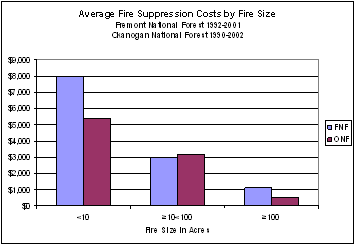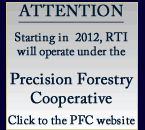|
May 2004
By Larry Mason, Bruce Lippke & Kevin
Zobrist
| As a consequence of large intense forest fires
in the inland west over recent years, considerable public attention
is being directed at the question of how to reduce hazardous
fuel loads from the overly dense forests that characterize the
region. Removal of the many small trees that make up these fuel
loads is known to be costly. While large trees can be removed
for lumber and other product values as reflected in the market,
the market value for the smaller logs may be less than the harvest
and hauling charges, resulting in a net cost for thinning operations
that are needed to lower fire risk. However, failure to remove
these small logs results in the retention of ladder fuels that
support the transfer of any ground fire to a crown fire with
destructive impacts to the forest landscape. A recently completed
cost/benefit analysis conducted by the Rural Technology Initiative
(RTI) as part of a broad investigation of fire risk reduction
indicates that the negative impacts of crown fires are underestimated
and that the benefits of government investments in fuel reductions
are substantial. |
|
| There are many market and non-market values associated with
reduction of fire risk that should be important to forest managers
and to society at large. An analysis of fire risk and hazardous
forest fuels on the Fremont (OR) and Okanogan (WA) National
Forests indicates that the negative impacts of crown fires are
underestimated and the benefits of government investments in
fuel reductions are substantial. Perhaps most obvious is the
escalating cost of fighting forest fire, which nationally has
been in the billions of dollars during recent years. Similarly,
there is the value of avoiding facility losses and fatalities
that result from forest fires. Communities value a lower fire
risk and reduced smoke. Forest fires destroy visual aesthetics
and limit recreational opportunities. The United States Congress
has historically placed a very high value on species protection
as evidenced by laws such as the Endangered Species Act or the
National Forest Management Act yet irreplaceable habitats for
threatened and endangered species may be lost when forests burn.
Valuable timber resources are destroyed. Fires also convert
the carbon stored in forest biomass to smoke reducing the opportunity
to produce long lasting pools of carbon stored in forests and
products while adding to atmospheric carbon and global warming.
Fires consume biomass that otherwise could be used for clean
energy conversion and green energy credits. |
 |
Regeneration after fires is problematic
and costly and rehabilitation investments are often needed to
avoid serious erosion, sedimentation, and water contamination.
If forests are thinned, the resulting increase in available
surface water could benefit salmon habitats, municipal reservoirs,
and agricultural irrigation. Rural economic development benefits
would result from the taxes and rural incomes generated by fuel
reduction activities. Since economic activity in these regions
has been in decline as a consequence of lower federal timber
harvests, any reduction in unemployment has higher than normal
leverage on state and local finances by lowering assistance
costs. |
| Figure
1. |
Average fire suppressions
costs -
Fremont and Okanogan National Forests. |
|


| Many scientific studies have shown that forests thinned to
remove fuel loads are unlikely to experience crown fires. Accounting
for the full value of this reduced risk exposure, however, must
take into consideration both the predicted costs and the timing
of future fire events. While it is impossible to predict exactly
when a future fire might occur in a specific location, we do
know that due to decades of fire suppression, the time since
last ignition in many forests is well beyond previous fire return
cycles and that present fuel loads are well outside of historic
levels. Fire ecologists agree that the question is not whether
these forests will burn but when. To illustrate how the relative
costs and benefits of investments in hazardous fuels removal
treatments to reduce risk of crown fires might be considered,
a parametric table can be constructed to display the present
value of anticipated future costs associated with failure
to reduce risk.. For this example, we will assume that that
all acres of forests with a present high risk, if left untreated,
will burn sometime in the next 30 years while all those forests
considered at moderate risk will burn sometime in the next
60 years. If there is an equal probability of each acre burning
in any year during the assigned interval then for approximation
purposes we can assume that an average time for all acres
to burn is equivalent to one-half the interval.
|
|
Figure 2. Parametric
present valuation estimation of non-market values. |


| In other words, an equal probability that all
acres burn sometime in 30 years means an average time to burn
of 15 years and correspondingly, given a 60-year interval, the
average burn time will be 30 years. If we further assume, as
is often done for financial analysis, that an inflation-adjusted
interest rate of 5 % is representative of the average anticipated
cost of money throughout the risk interval then we have what
we need to discount future cost estimates to present dollars.
In the example above, an estimated future average fire fighting
cost of $1000 per acre is used to demonstrate the present value
of a future liability. This example shows that every dollar
that will be needed to fight forest fires during the 30-year
period for high risk represents $0.48 of anticipated cost exposure
today and during the 60-year period for moderate risk represents
$0.23 today. Conversely, investments in fuels removals today
are worth the savings represented by these present value estimates
of costs avoided if fires do not occur. Other values of interest
can be similarly assessed and then summed to estimate broad
present benefit from investment in risk avoidance. The following
table shows present value estimates of avoided future losses
associated with a number of market and non-market values.
Also displayed for comparison are Forest Service contract
preparation costs and operational costs. Future values are
taken from a variety of governmental and non-governmental
information sources while contract and operational estimates
are derived from figures provided by the Okanogan and Fremont
National Forests as well as from interviews with harvest contractors.
Treatments are assumed to be forest thinnings within the understory
that leave approximately 40-100 of the biggest trees per acre
(TPA). A more rigorous explanation of this estimation methodology
and source information can be found on the RTI web site, www.ruraltech.org
, in the Market and Non-Market Values section of the RTI report
entitled “Investigation of Alternative Strategies for
Design, Layout, and Administration of Fuel Removal Projects”.
Printed copies of the full report are available upon request
or can be downloaded from the website.
|
| Table 1. |
Summary table of costs
and benefits from fire risk reductions. |
| Treatment Benefits |
Value per acre |
High Risk |
Moderate Risk |
| Fire fighting costs avoided |
$481 |
$231 |
| Fatalities avoided |
$8 |
$4 |
| Facility losses avoided |
$150 |
$72 |
| Timber losses avoided |
$772 |
$371 |
| Regeneration and rehabilitation costs avoided |
$120 |
$58 |
| Community value of fire risk reduction |
$63 |
$63 |
| Increased water yield |
$83 |
$83 |
| Regional economic benefits |
$386 |
$386 |
| Total Benefits |
$2,063 |
$1,286 |
| Treatment costs |
|
|
| Operational costs |
($374) |
($374) |
| Forest Service contract preparation costs |
($206) |
($206) |
| Total Costs |
($580) |
($580) |
| Positive Net Benefits from Fuel Removals |
$1,483 |
$688 |
| |


| Additional benefits from fuels reductions
such as habitat restoration, water quality protection, carbon
credits, and others are more difficult to estimate but are
generally considered to be of high public value. Further research
is needed to quantify such benefits; however, it should be
apparent that addition of such considerations will serve to
increase further the net value of public investments in forest
fire risk reduction.
Potential negative costs associated with harvest activities
to reduce hazardous fuel loads might include environmental
impacts of soil compaction, damage to leave trees, and road
sediments. However, these costs are difficult to estimate
and may be avoided with due diligence. Compromises to habitat
quality for some species may decline while others increase,
creating tradeoffs that are difficult to evaluate, but these
changes are not likely to be as harmful as the impacts of
catastrophic wildfires.
While the values assigned to the benefits from fuels reductions
that have been listed above can rightly be considered coarse
estimates, they have been shown to be legitimately defensible
and intentionally conservative. These figures suggest that
the benefits of fire risk reduction are of high value and
generally of much higher value than any market losses resulting
from thinning to reduce the fire risk. It is worthy to note
that many areas of the forests studied in this investigation
showed positive net returns from log sales after thinning
simulations when some larger trees were removed as part of
the fuels reduction activity. However, even with an assumed
net cost of fuel reduction operations, the results of this
cost/benefit analysis clearly show that the future risk of
catastrophic fire on the National Forests of the inland west
is far costlier to the public than investments made today
to protect against such eventuality.
An analysis of Fremont and Okanogan National Forest inventory
data indicated that 1,307,667 acres (greater than 75% of the
total forest area) are at moderate to high risk of crown fire.
Based upon present value estimations above, the total no-action
liability for these at-risk forests is greater than 2 billion
dollars. The net public benefit of hazardous fuels reductions
after subtraction of operations costs for just these two National
Forests is estimated to be greater than 1.3 billion dollars.
|
|







